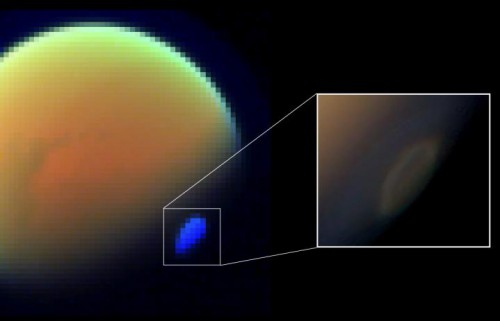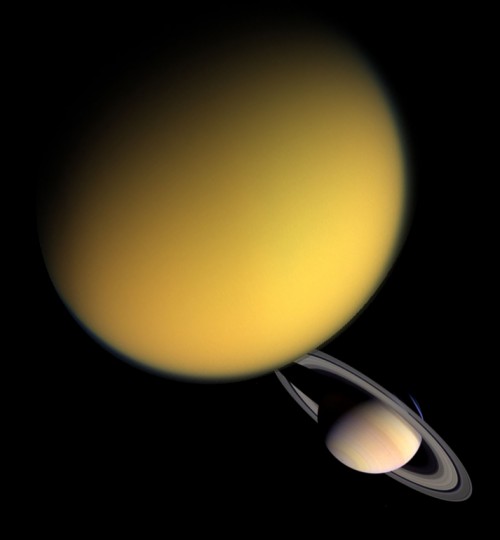
Titan is the only moon in the Solar System known to have a dense atmosphere, and while similar to Earth’s atmosphere in some ways, such as being rich in nitrogen, it also holds surprises for planetary scientists. Analysis of data from Cassini of a huge cloud which hovers over the moon’s south pole shows that it is both toxic and colder than expected.
“The discovery suggests that the atmosphere of Titan’s southern hemisphere is cooling much faster than we expected,” said Remco de Kok of Leiden Observatory and SRON Netherlands Institute for Space Research, lead author of the study published in the journal Nature. It was also discovered that the cloud, a swirling polar vortex, contains frozen particles of the toxic compound hydrogen cyanide (HCN).
The cloud, several hundred miles across, was first seen by Cassini in May 2012 as it began to form over the south pole. It appeared to be occurring in conjunction with the changing seasons; it was autumn in Titan’s southern hemisphere at the time, and because Titan is so far from the Sun, each season lasts about seven years. Summer in Titan’s southern hemisphere had started to change to autumn in 2009.

The altitude of the cloud was also unusual, about 200 miles (300 kilometres) above the surface, where it had been thought too warm for such a cloud to form. According to de Kok, “We really didn’t expect to see such a massive cloud so high in the atmosphere.” But there it was.
So how did it form? A clue was found in the spectrum of sunlight reflected by Titan’s atmosphere. “The light coming from the polar vortex showed a remarkable difference with respect to other portions of Titan’s atmosphere,” said de Kok. “We could clearly see a signature of frozen HCN molecules.” Scientists mapped the distribution of chemical compounds in Titan’s atmosphere and on its surface using Cassini’s visual and infrared mapping spectrometer (VIMS), which led to the discovery of the toxic compound.
HCN was already known to be present in the atmosphere in small amounts as a gas, but wasn’t expected to be in frozen form also, since that would require temperatures of -234 degrees Farenheit (-148 degrees Celsius). Titan’s upper atmosphere was thought to be about 200 degrees Fahrenheit (100 degrees Celsius) warmer than that.
As it turned out, data showed that the atmosphere in Titan’s southern hemisphere had been cooling rapidly, so the cooler temperatures needed for the cloud to form were certainly possible.
“These fascinating results from a body whose seasons are measured in years rather than months provide yet another example of the longevity of the remarkable Cassini spacecraft and its instruments,” said Earl Maize, Cassini project manager at NASA’s Jet Propulsion Laboratory in Pasadena, Calif. “We look forward to further revelations as we approach summer solstice for the Saturn system in 2017.”
From its rivers, lakes, and seas of liquid methane to an underground water ocean to weird toxic clouds high up in the atmosphere, Titan is a complex and fascinating world, and one of the most interesting places in the Solar System for continued exploration.
Want to keep up-to-date with all things space? Be sure to “Like” AmericaSpace on Facebook and follow us on Twitter: @AmericaSpace




” . . . . one of the most interesting places in the Solar System for continued exploration.” From your lips to God’s ear Paul! If we had only a fraction of the money that is, and will be, spent on baseball hats, T-shirts, etc. for the upcoming baseball championship games, a flagship spacecraft would be on its way to Titan. How heartbreaking it must be for the highly intelligent, dedicated NASA engineers, physicists, computer scientists who have devoted their educations – their very lives, to planetary exploration only to be denied what they are so eager to do because the money is spent elsewhere.